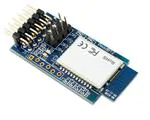1300 Henley Court
Pullman, WA 99163
509.334.6306
www.digilentinc.com
PmodBT2™ Reference Manual
Revised April 15, 2016
This manual applies to the PmodBT2 rev. A
Overview
The PmodBT2 is a powerful peripheral module employing the Roving Networks® RN-42 to create a fully integrated
Bluetooth interface.
Features include:
The PmodBT2.
1
Bluetooth 2.1/2.0/1.2/1.0 compatible
Add wireless capability with this low power, Class 2
Bluetooth radio
Supports HID profile for making accessories such as
pointing devices, etc.
Secure communications, 128-bit encryption
Supports Bluetooth data link to iPhone/iPad/iPod Touch
Six different modes
Small PCB size for flexible designs 1.5“ × 0.8” (3.8 cm × 2.0
cm)
12-pin Pmod port with UART interface
Functional Description
The PmodBT2 uses a standard 12-pin port and communicates via UART. There is a secondary SPI header on the
board for updating the RN-42 firmware if needed.
1.1
Jumper Settings
The PmodBT2 has several modes available to the user via jumper settings. JP1 through JP4 provide various modes
of operation as indicated in Table 1 below. Each jumper is active when shorted. JP1 restores the device to factor
default settings after three transitions of the jumper setting (short-to-open or open-to-short). After the third
transition, the device returns to factor default except for the Bluetooth name. The other three jumpers, JP2-JP4,
only sample in the first 500 ms of operation to allow the pins that they tie to on the RN-42 module to serve a
separate purpose later in the modules operation. JP2 enables pairing with a special device class defined by the
user in software. This may be used so that the PmodBT2 operates as a substitute for an RS232 cable. JP3 enables
auto connect to a stored address defined by the user. Finally, JP4 chooses whether to operate at the stored baud
DOC#: 502-214
Copyright Digilent, Inc. All rights reserved.
Other product and company names mentioned may be trademarks of their respective owners.
Page 1 of 3
�PmodBT2™ Reference Manual
rate (115.2kbps default) or a baud rate of 9600 regardless of the software selected rate when shorted. For more
detailed information on jumper settings and functionality, refer to the RN-42 user manual.
Jumper
JP1 (PIO4)
JP2 (PIO3)
JP3 (PIO6)
JP4 (PIO7)
Description
Factory Default
Auto Discovery/Pairing
Auto Connect
Baud Rate Setting (9600)
Table 1. Set jumper description.
RTS
1
RXD
2
Roving
Network
RN-42
TXD
3
MISO
1
MOSI
2
SCK
4
CTS
CS
5
GND
GND
VCC
VCC
6
3
4
5
6
J2
7
STATUS
8
RST
9
NC
10
NC
1 2
11
GND
3 4
12
VCC
VCC
5 6
7 8
JP1
JP2
JP3
JP4
J1
Figure 1. PmodBT2 block diagram.
1.2
UART Interface
By default, the UART interface uses a baud rate of 115.2 kbps, 8 data bits, no parity, and a single stop bit. The
startup baud rate may be customized to predefined rates or set to a specific user customized baud rate.
Predefined baud rates range from 1200 to 921k.
The reset pin (RST) on J1 is active low. If the RST pin is toggled, the device will undergo a hard reset. This hard reset
performs similarly to a power cycling of the device. The second interface besides the standard UART signals is the
STATUS pin also on J1The STATUS pin directly reflects the connection status of the device. STATUS is driven high by
the device when connected and is driven low otherwise.
For more information on the devices UART interface and RST and STATUS pins refer to the RN-42 user manual on
the Roving Networks website.
1.3
Command Mode
Copyright Digilent, Inc. All rights reserved.
Other product and company names mentioned may be trademarks of their respective owners.
Page 2 of 3
�PmodBT2™ Reference Manual
In order to enter the command mode, the PmodBT2 must receive "$$$" to which it will respond "CMD". When in
command mode, the module will respond to a large number of commands allowing the user to customizing the
module for specific applications. In order to exit command mode, send "---" (three minus signs in a row and
where stands for the carriage return character) to which the device will respond "END". Remote
configuration, or configuration over a Bluetooth connection, is possible through the command mode but has
several restrictions. The configure time, which defaults to 60 sec, defines the time window in which the PmodBT2
may be configured remotely. Outside of this time, the PmodBT2 will not respond to any remote commands. It is
important to note that any of the "set" commands available for the PmodBT2 must be followed by a power cycle
to take effect in any design.
Connector J1 – UART Communications
Pin
Signal
Description
1
RTS
Ready to Send
2
RX
Receive
3
TX
Transmit
4
CTS
Clear to Send
Power Supply
5
GND
Ground
Power Supply
6
VCC
(3.3V)
7
STATUS
Connection Status
8
~RST
Reset
9
NC
Not Connected
10
NC
Not Connected
Power Supply
11
GND
Ground
Power Supply
12
VCC
(3.3V)
Connector J2 – SPI Connector (Firmware Update Only)
Master in/ Slave
1
MISO
out
Master out/ Slave
2
MOSI
in
3
SCK
Serial Clock
4
~CS
Chip Select
Power Supply
5
VCC
(3.3V)
Power Supply
6
GND
Ground
Table 2. Connector descriptions.
The various modes of operation are accessed by using the "SM," command while in command mode.
The PmodBT2 can be put into one of six available modes of operation. The modes in order, 0 to 5, are: slave,
master, trigger master, auto-connect, auto-connect DTR, and auto-connect ANY. For more detailed information on
the different modes of operation, refer to the RN-42 user manual. For the full list of device commands, how to use
remote configuration, and more detailed information on the different modes of operation, see the RN-42 data.
Copyright Digilent, Inc. All rights reserved.
Other product and company names mentioned may be trademarks of their respective owners.
Page 3 of 3
�
很抱歉,暂时无法提供与“410-214”相匹配的价格&库存,您可以联系我们找货
免费人工找货